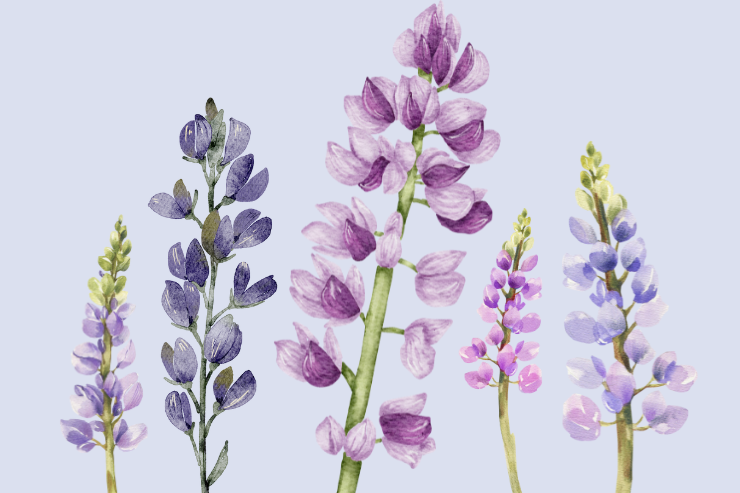
For years, I noticed wild Lupine growing along highway roadsides, their colorful spikes standing out against the asphalt and guardrails. These flowers always caught my eye, but I didn’t know what they were called until I finally looked them up in my late twenties.
Intrigued by these wildflowers, I decided to try growing Blue Lupine in my own butterfly garden. The first time, I bought a plant. It died fairly quickly, I blame a local bunny who seemed to like it more than the other plants. To combat this, I grew strawberries as mulch around the perimeter to keep him busy. The next year, I ordered some seeds and planted them, curious to see how they’d turn out. To my surprise, they not only grew well and quickly, but also attracted a lot of butterflies to my garden.
As the seeds sprouted and the plants grew, I watched with interest. When the blue flower spikes finally bloomed, they were quite striking. But here’s an interesting fact: Blue Lupine isn’t just pretty to look at; it’s also one of the few lupines that are edible for humans. But we’ll come back to that later.
Let’s talk about why butterflies love Blue Lupine so much. The tall flower spikes are eye-catching, but they’re also packed with nectar that butterflies find irresistible. I’ve seen many different types of butterflies visit my Blue Lupine, from small Hairstreaks to large Swallowtails. They move from flower to flower, drinking the nectar.
But Blue Lupine isn’t just a food source for adult butterflies. Many butterfly species, especially in the Lycaenidae family, use Lupine as a host plant for their caterpillars. This means that by planting Blue Lupine, you’re providing a place for butterflies to lay eggs and for their caterpillars to grow.
It’s been fascinating to watch the whole butterfly life cycle in my garden. I’ve seen eggs on the leaves, caterpillars eating the plants, chrysalises hidden in the foliage, and new butterflies emerging. Seeing a newly emerged butterfly take its first flight from a Blue Lupine plant is always a special moment.
How to Grow Blue Lupine for Your Butterfly Garden
Let me share a few fun facts that might just make you fall in love with these flowers as much as I have:
- Blue Lupine is a nitrogen-fixing plant, meaning it actually improves soil quality as it grows. It’s like having a gardener and a butterfly attractor all in one!
- In some parts of the world, Blue Lupine is grown as a crop. Its seeds are high in protein and are used in everything from animal feed to human food.
- The ancient Romans believed lupines had magical properties and used them in various rituals. Maybe that’s why my garden feels a bit enchanted when they’re in bloom!
- Blue Lupine is part of the legume family, related to peas and beans. No wonder butterflies find them so delicious!
Now, I know you’re itching to get your hands dirty and plant some Blue Lupine of your own. Here are my top tips for growing these beauties:
- Sun lovers: Blue Lupines thrive in full sun. Give them at least 6 hours of direct sunlight daily for the best blooms.
- Well-drained soil is key: These plants don’t like wet feet. If your soil is heavy clay, consider amending it with some compost or sand.
- Cool customers: Blue Lupines prefer cooler temperatures. They’re perfect for gardens in USDA zones 4-8.
- Water wisely: While establishing, keep your Blue Lupines consistently moist. Once they’re settled in, they’re fairly drought-tolerant.
- Feed sparingly: Too much fertilizer can lead to lush foliage but fewer flowers. A light feeding in spring is usually sufficient.
- Deadhead for more blooms: Remove spent flower spikes to encourage a second flush of blooms and prevent excessive self-seeding.
- Give them space: Blue Lupines can grow up to 4 feet tall and 2 feet wide. Plant them with enough room to spread their wings (or leaves, in this case).
Edible Lupines? Tell me more!
Blue Lupine isn’t just a treat for butterflies; it can be a delicious addition to our own diets too.
While many lupines are bitter and toxic, certain “sweet” varieties like Blue Lupine are safe and nutritious for human consumption. These edible lupines can be soaked and used in various dishes, from stews and salads to burgers. They can even be ground into flour for baking cakes and pancakes. Lupine kernel flour is gaining popularity as a high-protein alternative in cooking. Some creative cooks have even made lupine hummus and tofu-like curds. It’s worth noting that if you’re planning to eat lupines, make sure you’re using a sweet, edible variety and prepare them properly. Always soak them for at least an hour before cooking to remove any remaining bitter compounds. With their versatility and nutritional benefits, edible lupines are becoming an increasingly popular plant-based protein source.
So, are you ready to add a touch of edible azure allure to your butterfly garden? Trust me, once you’ve experienced the joy of Blue Lupines—from the butterflies they attract to the culinary adventures they offer—you’ll wonder how your garden ever did without them!
And if you want to learn more about planting a butterfly garden, download our Butterfly Gardening in America GuideBook. It includes charts that are divided into sections, so you know which plants or flowers you can grow based on the type of soil and amount of sun your garden gets. We also cover history, popular varietals, plant hardiness zones, and basic care instructions for nurturing natures winged wonders. Download now!
I’m eager to hear from you all. Have you grown Blue Lupines before? What’s been your experience with edible flowers in the garden? And for those of you intrigued by the idea, what other dual-purpose plants are you considering for your butterfly garden? Share your thoughts in the comments below—let’s create a buzz about these beautiful blues!




Are all blue lupines edible ?
Yes!